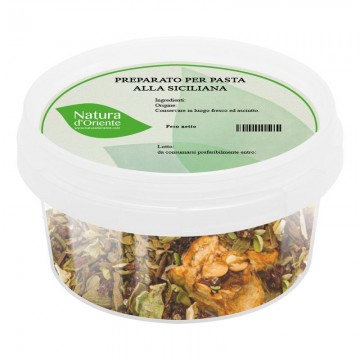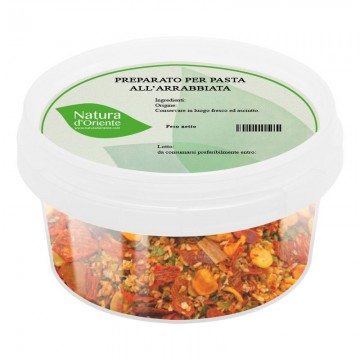Pasta alla puttanesca is a typical Neapolitan dish based on olives and capers, highly appreciated for its intense and slightly spicy taste and for the ease and speed of making recipe. The latter features that we find at the basis of the various theories on the origin of the curious name.
The recipe for pasta alla puttanesca
The main ingredients are olives and capers, flanked by peeled tomatoes, oil, garlic, chilli and oregano (and / or parsley), this is the most accredited recipe as "traditional" , but given the characteristic of a quick dish in which you can put a little bit of what you have available at the basis of its birth there is no shortage of variants. In the Lazio version of the puttanesca, or rather I should say the spaghetti alla puttanesca since this recipe is today inextricably linked to that cut, anchovies have been added. Even without anchovies it is still a tasty and slightly spicy dish.
History of pasta alla puttanesca
There is no doubt that the recipe predates the curious name that appeared only in the middle of the last century, previously in Naples it was known simply as pasta "aulive e chiapparielle" or olives and capers. But already in the first half of the nineteenth century, in the manual "Theoretical-practical cuisine" by Cavalier Ippolito Cavalcanti Duca di Buonvicino, in which Neapolitan recipes are collected, you can find the "Vermicelli all'oglio with olives, capers and anchovies sauces" that everyone already has the main ingredients of puttanesca.
Searching for the origins of the curious name we found three different anecdotes and we discovered, to our great surprise, that in two of them the adjective puttanesca does not allude to the expression " puttanata ”but with the literal meaning relating to the so-called“ oldest profession in the world ”.
According to an anecdote the name was born in a brothel, according to some version of Rome (we are talking about the beginning of the last century when it was already the capital of the Kingdom of Italy) not Naples , but according to the famous gastronome "Arthur Schwartz" the origin would instead be in some "pleasure house" in the Spanish quarters of Naples. According to the story told (or imagined?) The owner of a brothel decided to offer a lunch to the customers and then prepared a pasta with a sauce to be made quickly with the ingredients that were there.
There is a hypothesis that if the name of the dish was really born in that area it could be due to the fact that the many colors of the pasta alla puttanesca recall the brightly colored underwear with which the girls attracted customers, instead another story even identifies the author of the recipe in a girl "of life" "Yvette the French", who with a cheerful character and not at all ashamed of her profession would have ironically called the dish.
There is also an anecdote that would identify the place and time in which the name was born, even if the meaning of "puttanesca" has nothing to do with the world of prostitution but it comes from "puttanata". At the beginning of the 1950s the architect Sandro Petti ran a tavern called "Rancio Fellone", one evening he found himself having to feed a group of friends, but he had already finished everything, when he communicated the bad news he was answered with the 'exhortation "Come on Sandro, it's late and we're hungry, where do you want us to go ... do any whore with us".
Instead the cook and author of cookbooks Jeanne Caròla Francesconi attributes the authorship of the dish and name to the Ischian painter Eduardo Maria Colucci who was an uncle of Petti, but Francesconi in her book confirms a nice anecdote remembered by Petti (who instead claims the paternity of the dish and name): the bishop Ernesto De Laurentiis, sent for the architect and restaurateur for a matter of great urgency, after having messed around embarrassed, among the confusion of Petti who he did not understand what he wanted, the prelate finally got to the point by saying that the name of the pasta alla puttanesca that made a fine show of itself in the menu displayed in the window was not worthy of him.
For what our opinion counts, first of all, given what is written on the recipe reported by Cavalcanti, it seems really unlikely to look for the origin of the dish in these more recent anecdotes (assuming they are true) , given that the combination of olives and capers was already well known in Naples, if anything that of the curious name pasta alla puttanesca.
Also for this reason we lean towards the meaning ofputtanesca = puttanata to be prepared quickly, after all, both in the anecdote relating to Petti (or uncle) and in that of Schwartz, it is remembered that at the base of the dish there is the quick preparation with remedied ingredients because they are among the most common.
Curiosities about pasta alla puttanesca
The first explicit reference with this name to "spaghetti alla puttanesca" is that of Raffaele La Capria in the novel Ferito a morte (1961), which mentions "spaghetti alla puttanesca" as they do in Syracuse ".
One of the main points on which the different recipes of pasta alla puttanesca do not agree is the quantity of tomato, according to someone including the aforementioned Petti there would be little tomato "just to color the dish ”, in other versions the recipe is almost a tomato-based pasta with the addition of olives and capers.
Even if there is no disciplinary, an officially codified recipe for pasta alla puttanesca, it should be remembered that in 1931 the Italian Touring Club included a dish in its "gastronomic guide of Italy" as a gastronomic specialty of the Campania region which bears the name of "Maccheroni alla marinara" but which has all the ingredients of puttanesca.





 No reward points for this product.
No reward points for this product.











